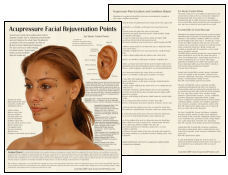Acupuncture & TCM Articles

Articles by Mary Elizabeth Wakefield, LAc, Dipl. Ac., MS, MM
Mary Elizabeth Wakefield has 27 years of clinical professional experience as a healing practitioner, and is a licensed acupuncturist, certified by the NCCAOM, a Zen Shiatsu practitioner, massage therapist, a cranio-sacral therapist, Acutonics® practitioner, opera singer, herbalist and Interfaith minister.
She is a graduate of Tri-State College of Acupuncture in New York City, and has studied with such notable acupuncturists as Carolyn Bengston, Kiiko Matsumoto, Dr. Mark Seem, Arya Nielson, Jeffrey Yuen, Dr. Richard Tan, Fabien Maman, Yitian Ni and Donna Carey.
Her knowledge of facial acupuncture and acupressure is based on the work of Jacques Lavier, the "Father of French Acupuncture." She has also studied extensively with her teacher Carolyn Bengston, who is a master of interdermal needling for the face.
For more information about Ms. Wakefield's Constitutional Facial Acupuncture Renewal™ seminars, please visit her website at www.chiakra.com
Changing the Face of Aging
Stress and the Adrenals: The Incredible Burden of "Doing" vs. the Lightness of "Being"
By Mary Elizabeth Wakefield, LAc, Dipl. Ac., MS, MM and Kiera Lane, NMD, MS Ac., LAc, Dipl Ac.
Stress is one of the most prevalent influences in our lives today. In Australia, for example, neurotic, stress-related and somatoform disorders resulted in 49,415 hospitalizations in 2001-2002, while 95 percent of hospital consultant episodes were a consequence of adjustment disorders and reactions to severe stress.1 Our daily lives are an orchestration of duties, responsibilities and detailed tasks that seem to be never-ending and take a toll on our bodies.
Over time, this persistent influence in our lives leaves its seemingly indelible imprint upon the lines, expressions and vitality of our faces, where the influences of heaven and earth merge to create a canvas of our individual lives. Although these visible manifestations of stress may appear more readily in those habitual, contracted movements of the facial muscles, the face itself is not the culprit. Rather, its altered landscape should provide us with the stimulus to look elsewhere in the body to identify those sources of stress that may be best addressed through lifestyle changes, an indispensable adjunct to the holistic treatment protocols of constitutional facial acupuncture renewal.
In this manner, the face can be seen to function as a barometer for the overall "climate" of the body itself, and stress evident in the face telegraphs the presence of physiological imbalance elsewhere in the body. According to Taoist monks, the human body was considered to be a microcosm of the entirety of creation, exhibiting the perfection of the universe as a manifestation of the Divine in its fundamental symmetries and ideal harmony of functioning. The face, the body's most emotive part, was seen as a similar system, an encapsulation of the three treasures – qi, jing and shen.
As the sage Lu Tung-Pin said:
The human body is composed entirely of essence, energy and spirit. If you do not cherish your essence, and dissipate it recklessly, it is like pouring water into a cracked cup. Instead of filling the cup, it will leak away until it is depleted to the last drop.
If you do not cherish your energy, and dissipate it carelessly, it is like putting incense on hot coals and continuously adding fuel to the fire until the incense has burned to ashes.
If you do not cherish your spirit, and dissipate it indiscriminately, it is like setting a lamp out in the wind unprotected, letting the wind blow on the flame until it is extinguished.
The question one could pose when attempting to examine the effects of stress is: Can an individual's vessel, or body, hold their jing? Is this even possible in a society that is clearly "running on empty," in which individuals on the fast track of highly paid careers routinely dissipate their jing and qi in the pursuit of increasingly materialistic goals? Their bodies may not exhibit any excess fat, but their lack of authentic vitality is clearly evident in the exhausted, flat expressions that emanate from their eyes.
The answer to this question is, of course, crucial to the Oriental medical practitioner. The patient described above would be treated using herbs, according to specific TCM patterns or in response to the perceived Five-Element imbalances, with specific recommendations for improved diet, nutrition and other lifestyle changes.
The Adrenal Glands

In Western medicine, one of the most important, but overlooked, aspects of physiological regulations of stress relates to the multifunctional endocrine organs known as the adrenal glands.
In TCM, they are best associated with the water element, kidney. The adrenal glands are located above each ipsilateral kidney and play a vital role in stress modulation and the synthesis of sex hormones. The adrenals secrete three important steroid hormones: cortisol (a glucocorticoid), aldosterone (a mineralocorticoid), and androgen precursors, largely dehydroepiandrosterone (DHEA). The adrenals are essential to life and are involved in a multitude of physiological activities, including blood sugar regulation, protein turnover, fat metabolism, sodium, potassium/calcium balance, modulation of tissue response to injury or infection, and sex hormone production.
Insufficient cortisol production is known as Addison's disease, and excessive secretion is known as Cushing's syndrome. Both of these conditions are considered serious and require immediate medical treatment to counteract their effects. Common signs and symptoms of Addison's disease include: fatigue, muscle weakness, nausea, vomiting, craving for salt, polyuria (related to the water element), weight loss, melasma suprarenale or hyperpigmentation, and postural dizziness. By contrast, Cushing's syndrome is the result of the overproduction of cortisol, commonly caused by a neoplasm in the pituitary gland that stimulates an overproduction of cortisol from the adrenals, through the release of excessive adrenocorticotropic hormone (ACTH). Symptoms of Cushing's syndrome may include: fatigue, high blood pressure, high blood sugar, weight gain in the trunk and face, excessive perspiration, telangiectasia, bruising due to the thinning of the skin, facial hair, anxiety, and depression.
The Decline of Adrenal Hormones in the Process of Aging
Cortisol secretion, which is highest in the morning and slowly declines throughout the day, is important in energy and how vital we feel, proper sleep regulation, fat metabolism, and anti-inflammatory and immune response. The sex hormone precursor DHEA, which is synthesized from pregnenolone, is an important precursor to other sex hormones, such as estradiol and testosterone. In women, these precursors supply about half of the androgenic hormone requirements. That means that during perimenopause and menopause, when ovarian decline occurs and the primary producers of our sex hormones decline, the adrenals are the only major source left to support hormone production.
Therefore, the slow decline of sex hormones naturally in the aging process and the exposure of chronic stress place a burden on the adrenal glands to compensate and work harder to support our daily activity. This decline has a myriad of implications by affecting our sleep cycles, vitality, sexual desire, immune response, pain/inflammation response, and our body fat composition.
Adrenal Fatigue
What happens when there is no disease, but a down-regulation of function? Common symptoms associated with a down-regulation of adrenal function are: fatigue, insomnia, weight gain, reduced libido, pain, poor memory, fluid retention, skin inflammation, low blood pressure, low body temperature, craving of stimulants (such as coffee for energy), frequent colds, flu and infections, mood changes, and suboptimal response to stress.
Adrenal fatigue is not a disease; it is a condition that reflects a subtle reduction in adrenal function and reserve that significantly impacts our physical and emotional well-being. Adrenal fatigue can be identified based on presenting symptoms, physical examination, and diagnostic salivary testing of DHEA and diurnal 24-hour cortisol.
The following nutritional, botanical and glandular support of adrenal function can enhance vitality and restore proper adrenal function:
Nutritional Support of Adrenals:
Vitamin C, E, and the B vitamins, especially pantothenic acid (B5), are important nutrients needed for proper adrenal function. Most of these nutrients can be found in the colorful (green, red, yellow, orange) fruits and vegetables, such as spinach, broccoli, kale, yellow and red peppers, and butternut squash. Addition of these foods supplies the proper nourishment for the adrenals to do their job. Oral supplementation also can be provided for further support.
Botanical Support:
There is a multitude of medicinal herbs that serve as adaptogens, which help our body to adapt to stress and hypo- or hyper-regulation. Some common adaptogenic herbs used to treat adrenal fatigue include: shisandra (Schisandra chinesis or wu wei zi), ashwaganda (Withania somnifera), gota kola (Centella asiatica), licorice root (Glycyrrhiza glabra), which is contraindicated in hypertension, and Siberian ginseng (Eleutherococcus senticosus).
Glandular Support:
Adrenal glandular extracts typically are made from a bovine source and are taken orally to nourish and stimulate your own adrenal production. They are commonly used for relatively short periods of time, such as three months, to restore function. If taken in high doses for too long, it may cause down-regulation through a negative feedback system. It is important to get a reputable source to avoid contaminants.
As we have previously attested, our society is composed of highly successful individuals who wear, as a badge of honor, the fact that they never sleep and routinely overwork, along with being a "superparent," juggling baby, bottle, work and play (although the latter is frequently left out of the equation). These overachievers pump up their tired adrenal glands with excessive amounts of caffeine and mounds of dark chocolate, because it is now "good" for us (both of these are, of course, heart yang tonics), or otherwise provide their exhausted bodies with the stimulation of alcohol, nicotine and overexercise.
The opportunity for authentic rest is only presented through the medium of that reluctantly indulged annual vacation, kept to an absolute minimum for any number of reasons. Should you decide to venture somewhat further afield than your living room sofa, new species of stress are added to the mix: airport security, flight schedules, unavoidable delays in your itinerary, traffic jams in new and exotic locales. After you arrive, you're determined to cram in as much "recreational" activity as possible, and then, it's back to work. Let's hop back on that treadmill once again, and run on our little wheel, like so many of the other hamsters in their cages.
When does this juggernaut cease? When we die? What a relief! We have found that the "running on empty" crowd becomes quite resentful when they actually experience a certain level of fatigue after an acupuncture treatment. They often don't come back. Some do become consistent and begin to reverse the effects of this pernicious adrenal fatigue; however this is only after it has become chronic. The suggestion of lifestyle changes prior to this point invariably falls upon deaf ears. Unfortunately, luxury "vacations" are ever so much more attractive an option for many.
In the midst of this obsessive "doing," we would do well to hearken back to those wise words of "being" from the sage Lu Tung-Pin: "Let us cherish our essence, honor our qi, and nourish our spirit before its flame is permanently extinguished."
Reference
"Statistics About Somatoform Disorders." AIHW Hospital Morbidity Database 2001-2002. Australia's Health 2004, AIHW. Available at: www.cureresearch.com/s/somatoform_disorders/stats.htm. Accessed June 1, 2007.
|
